Economy of British Columbia
This article may be unbalanced towards certain viewpoints. (March 2021) |
British Columbia (B.C.) is the third largest Canadian province by population[1] and fourth largest provincial economy.[2] Like other provinces in the Canadian federation, B.C. consists of both private and public institutions. However, as Canada's westernmost province, located between the Pacific Ocean and the Rocky Mountains, B.C. has unique economic characteristics that distinguish it from much of the rest of Canada.
Economic Geography[]
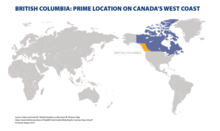
Geography has played a significant role in the province's economic development. B.C.’s location on Canada's west coast puts it at the commercial crossroads of the Asia-Pacific region and North America.
B.C. is geographically characterized by mountainous topography along with substantial areas of lowlands and plateaus. Though less than 5% of B.C.’s land is arable due to mostly mountainous terrain,[3] the province is agriculturally rich.[4] This can be attributed to relatively mild weather along the Pacific Northwestern coast and in various sheltered valleys.
There are eight economic regions within B.C.[5] This includes: the Cariboo, Kootenay, Lower Mainland/Southwest, Nechako, North Coast, Northeast, Vancouver Island and Coast, and Thompson/Okanagan region. In addition to the many towns and cities in these regions, the province is home to over 200 First Nations,[6] where many of these First Nations communities are actively involved in local economic development related to their traditional territories.
According to the most recent census data, 86% of the population is classified as urban and is highly concentrated along B.C.’s southern coast. Around 60% of B.C.’s population resides in the Lower Mainland region which includes the City of Vancouver. And not far to the west is Vancouver Island, which encompasses approximately 20% of the population, including Victoria, the provincial capital.[7]
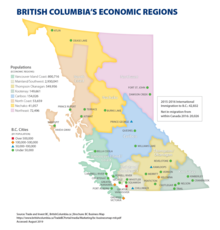
While service-based industries dominate its cities, resource-based sectors—principally forestry, agriculture, natural gas and mining, figure prominently as economic activities in less urbanized areas.[8]
Economic History[]
Indigenous peoples have lived in the area now known as B.C. for more than 10,000 years, where economic activities centred around fishing, hunting and food gathering. The area was home to thousands of Indigenous peoples when European explorers began to visit in the 1750s.[9] However, the area was difficult for early Europeans to reach, such that it was the last part of North America to be explored.
It was not until the first half of the 19th century that the Hudson's Bay Company expanded to the west of the Rocky Mountains and established trading outposts. The company sought to trade with Indigenous tribes, goods such as sea otter pelts and animal furs.[10] In 1849, Vancouver Island was colonized by the British and a lease was granted to the Hudson's Bay Company giving it exclusive trading rights on Vancouver Island. Soon after, the Gold Rush attracted tens of thousands of people to the interior areas of the province. B.C. remained a British colony until 1871 when it became a province of Canada. In 1885, the Canadian Pacific Railway was completed, linking the country from east to west. The railway increased trade and the movement of people and resources from the Atlantic to the Pacific.[11]
Around the turn of the 20th century, entrepreneurs came to B.C. to develop the province's vast natural resources and agricultural potential, ushering a period of rapid economic expansion and population growth. Major dams were built to support a growing electrical grid and the Trans-Canada Highway was completed, allowing for easier movement of goods and services. As population increased, it became concentrated around the ports in the southwest part of the province. Management and financial activities related to resource development remained in these coastal cities during this time, including Vancouver. Consumer-goods manufacturing also began in southwestern cities, due in part, to the high cost of transporting manufactured goods from eastern Canada and the US at the time.[12]

British Columbia has historically been a resource-dominated economy centred on the forest industry, with fluctuating importance in mining, farming and natural gas. About 60% of British Columbia is forested, accounting for approximately 19.5% of the forested land in Canada.[13] Today however, B.C.'s economy is more diverse, with service industries accounting for the largest portion (75%) of the province's gross domestic product (GDP). Over the past several decades, employment in resource industries has fallen steadily as a percentage of employment, and new job growth has occurred mostly in the construction, real estate, leasing and rental, and the retail/service sectors.[14]
Key Economic Indicators[]
| Metric | 2018 | 2017 | 2016 |
|---|---|---|---|
| GDP and Trade | |||
| Gross Domestic Product - GDP
(Millions of CAD dollars) |
$288,977 | $282,204 | $263,978 |
| Real GDP (% change) | 2.4 | 3.8 | 3.6 |
| Trade Exports (% change) | 3.5 | 3.4 | 3.8 |
| Trade Imports (% change) | 3.1 | 8.0 | 4.1 |
| Labour | |||
| Unemployment Rate (%) | 4.7 | 5.1 | 6.0 |
| Labour Force (% change) | 1.1 | 3.7 | 3.0 |
| Personal Income (% change) | 5.1 | 6.6 | 4.7 |
| Prices and Consumer Expenditures | |||
| Consumer Price Index (% change) | 2.7 | 2.1 | 1.8 |
| Retail Sales (% change) | 2.0 | 9.3 | 7.4 |
| Population and Migration | |||
| Population | 4,992,000 | 4,817,000 | 4,752,000 |
| International Migration (people) | 57,126 | 49,590 | 32,912 |
| Interprovincial Migration (people) | 3,902 | 10,202 | 20,026 |
Sources:
B.C. Financial and Economy Review (2019, 2018, 2017), Government of British Columbia[15]
B.C. Key Statistical Indicators (2019, 2018, 2017), Government of British Columbia[16]
Economic Analysis, B.C. Economic Forecast (2019-2022, 2018-2021), Central1 Credit Union[17]
Economic Infrastructure[]
Transportation[]
Air[]
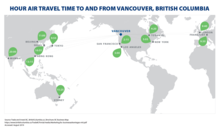
B.C. has six international airports, including: Victoria (YYJ), Vancouver (YVR), Kelowna (YLW), Abbotsford (YXX), Cranbrook (YXC) and Prince George International Airports (YXS).
Railways, Highways and Roads[]
British Columbia is the only gateway on the west coast of the Americas served by three continental Class 1 railways, connecting ports on the Atlantic, Pacific and Gulf coasts to key markets throughout Canada, the United States and Mexico. British Columbia has six railways crossings into the United States.
An extensive all-weather provincial highway and railway network makes transporting goods and services to North American markets seamless and reliable.[citation needed] B.C.'s well-maintained highway system allows efficient trucking across Canada and easy access to interstate highways in the United States. Computerized traffic management and integrated rail-truck terminals ensure effective freight transfer.[citation needed]
Sea[]

The Port of Vancouver is Canada's largest port and the third largest port in North America; it is responsible for Canada's trade with more than 170 world economies. The ports of Vancouver and Prince Rupert, which are ice-free year-round, are Asia's closest ports of entry on the west coast of North America—saving shippers more than two days travel time as compared to other west coast ports.[18]
Energy[]
More than 98% of the electricity generated in British Columbia comes from clean or renewable resources.[19] Electricity rates in British Columbia are also among the lowest in North America.[20]
British Columbia also has an abundance of natural gas, estimated at over 2,900 trillion cubic feet of marketable shale gas reserves. For more than 50 years B.C. has ranked second only to Alberta in natural gas production in Canada. In recent years, B.C. has begun to expand natural gas export capacity to markets beyond North America in the form of liquefied natural gas (LNG) that can be shipped to Asia.[21]
In 2018, the Government of British Columbia launched CleanBC, a plan to reduce emissions, advance the clean tech sector and grow B.C.’s low-carbon economy.
Communications and Networks[]
British Columbia has the highest rate of broadband and overall Internet connectivity in Canada. An extensive fiber-optic network and LTE services span the province.[22] However, due to predominantly mountainous terrain, many sparsely populated areas of the province offer no cellphone or internet services. An advanced communications infrastructure also provides telephone, broadcasting, cable, wireless and other information services.
Health and Education[]
B.C.’s education system includes 25 public post-secondary institutions with 165 campuses, satellites or learning centres, including 6 research universities.[23] There are also 350 private career training institutions with more than 50,000 students attending yearly.[24] British Columbia's trades training system currently serves more than 38,000 apprentices.[25] The quality of education in British Columbia is considered very high and Canada has the highest proportion of working-age adults who have been through higher education among developed countries in the world.[26]
The B.C. Ministry of Health is a provincial government body responsible for the administration of British Columbia's public health system. The ministry works with health authorities, health care providers, agencies and other organizations to guide and enhance the province's health services. The quality of healthcare in British Columbia is relatively similar to other Canadian provinces.[27] In Canada, public health insurance is available to all eligible Canadian citizens and permanent residents who can apply for provincial health coverage. In B.C., public health insurance is called the Medical Services Plan (MSP) and is managed by the Ministry of Health.
Government and Institutions[]
Canada, and in turn, British Columbia's system of government, is based on the British parliamentary model. Exclusive legislative powers are delineated between federal and provincial levels of government as defined by the Constitution of Canada. Municipal powers are delegated by each respective provincial legislature.
Legal tender used in B.C. is the Canadian Dollar, managed at the federal level by the Bank of Canada, which is also responsible for oversight of the Canadian financial system, including banking and monetary policies.
The B.C. government's annual budget is tabled for debate and vote in the provincial legislature every year in February. The Budget and Fiscal Plan is the main budget document that outlines the Province's three-year fiscal plan, including economic outlook, revenues, spending, tax measures, risks forecast and assumptions. The fiscal year runs from April to March. Healthcare, education and social development programs have historically been the largest B.C. government expenditures.[28]
British Columbia's general corporate income tax rate is 12%. When combined with the federal rate, B.C. businesses pay a general corporate income tax rate of 27%.[29] B.C. has the lowest provincial personal income taxes in Canada for single individuals earning up to $125,000 (CAD).[30] The sales tax rate for purchased retail goods in B.C. is 7% (PST). Both goods and services are also subject to a federal goods and services tax of 5% (GST).[31]
B.C. has one of the highest credit ratings among Canadian provinces, reflecting a strong balance sheet and depth and diversity of a fiscally stable economy. Agencies such as Moody's, Standard and Poor's, and Fitch rate B.C.’s debt as AAA and stable. As of March 2019, total provincial government debt stood at $66.0 (CAD) billion – representing 22.3% of B.C.’s nominal GDP.[32]
Trade and Investment[]
Trade Agreements[]
Companies with operations in British Columbia enjoy duty-free access to the world's largest marketplaces in Asia, North America and Europe thanks to the Comprehensive and Progressive Agreement for Trans Pacific Partnership (CPTPP), the North American Free Trade Agreement (NAFTA) and the Canada-EU Comprehensive Economic and Trade Agreement (CETA). In 2018, Canada, the US and Mexico negotiated a new trade agreement to supersede NAFTA, the Canada-United States-Mexico Agreement (CUSMA, also known as USMCA) which currently awaits ratification by governments of Canada and the United States.
Domestically, British Columbia, is a member of the New West Partnership Trade Agreement, which creates a single economic region encompassing British Columbia, Alberta, Saskatchewan and Manitoba: a marketplace of more than 11 million people and a GDP of more than $700 billion.
Exports[]
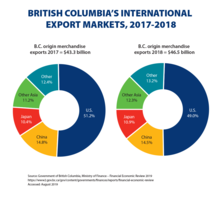

British Columbia is an important hub for goods shipped to and from Asia, and as a result, B.C.’s export markets are more diversified than Canada and other provinces.[33] While Canada typically sees over three-quarters of exports flow to the US, this market accounts for just over half of British Columbia exports. Other key markets for the province include China (15%), Japan (11%) and other Asian countries (12%).[34] The diversification of sectors and markets reduces the vulnerability of the B.C. provincial economy from sector-specific or trading partner-specific negative impacts.
Foreign Direct Investment[]

B.C. relies on foreign direct investment (FDI) to help drive economic growth. FDI enhances the ability of businesses and countries to expand capacity, resulting in more economic activity, more jobs, new sources of tax revenue, and gains in income. From 2012–16, B.C. ranked second only to the province of Ontario in attracting FDI in Canada.[35]
In 2016, half of inward FDI in Canada came from the United States.[36] Investments from Asia have increased and now account for 10% of FDI in Canada, significantly weighted in the energy and natural resource sectors.[37]
The B.C. provincial government promotes exports and FDI through a physical network of trade and investment offices around the world and through digital engagement.
Labour Force[]
B.C. has had the lowest unemployment rate in Canada since July 2017.[38] The province is home to a diverse and skilled workforce, characterized as being:
- Highly educated, with more than 60% having taken post-secondary education and well over a quarter possessing a university degree.
- Flexible, with more than 80% employed in service industries, including a quarter in professional, educational and business support services.
- Multilingual, with more than 400,000 British Columbia workers identifying one of the Chinese dialects as their first language. Another 139,000 have Punjabi as their first language. 52,000 identify themselves as speaking Korean.
 British Columbia's (B.C.) Workforce by Sector of Employment British Columbia's (B.C.)
British Columbia's (B.C.) Workforce by Sector of Employment British Columbia's (B.C.)
Over the next decade, demand for workers is expected to surpass supply in B.C. Several industries are expected to offer particularly strong job opportunities:[39]
- Green technology, digital media and life sciences,
- Traditional industries such as natural resources,
- Service industries, including healthcare, high-tech and retail sales.
The mandatory minimum wage in B.C. is $13.85 an hour as of June 2019 and is set to rise incrementally in coming years.
While the province attracts a healthy inflow of immigrants to help grow its labour force through government programs,[40] attracting and retaining skilled workplace resources in cities[41] with very high housing costs, poses a challenge for many B.C. businesses.
Economic Well-being[]
Due to a stable, sustainable economy, British Columbia compares favorably when evaluating key livability statistics. A temperate climate, cosmopolitan and culturally diverse cities, social stability, high-quality health care and education, and an abundant natural environment result in a quality of life and economic well-being that attract people to B.C. from around the world.[citation needed]
The Mercer Human Resource Consulting Group's 2019 Quality of Living Survey ranks Vancouver first in North America and third out of 231 cities worldwide.[42] The Economist Intelligence Unit (EIU), an affiliate of the Economist, consistently ranks Vancouver as one of the most livable cities in the world; in 2018, the top city in the Americas and fifth globally.[43] The EIU's rankings of 140 cities are based on stability, health care, culture, environment, education and infrastructure.
While B.C. is known globally for maintaining a high standard of living and being among the best places to live and work, the cost of living, and specifically housing affordability in Vancouver is exceptionally challenging. Even though Vancouver is often ranked as the most expensive city in Canada to live due to the high cost of housing,[44] it is still relatively modest when compared on a global scale to other major urban centres in respect to overall cost of living factors.[45]
Sectors[]
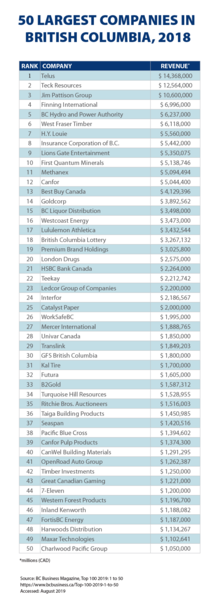
There were a total of 501,300 businesses in B.C. in 2017; of these, 98% were small businesses with fewer than 50 employees. Further, 83% of businesses in B.C. employed fewer than five employees, and 60% were self-employed individuals with no paid help.
In 2016, close to 6,900 B.C. businesses exported goods to destinations outside of Canada. Of these, over 5,900 (or 86%) were small businesses that shipped approximately $18 billion worth of goods to international destinations, making up 43% of the total value of goods exported from the province, with an average export value per business of just over $3 million.[46]
B.C.’s economy is diversified, which is reflected by a broad range of sectors that encompass its economy and largest corporations.
Aerospace[]
B.C.’s aerospace sector is the third-largest in Canada. More than 200 companies generate a total of $1.8 billion (CAD) in revenue annually and nearly 9,000 people are employed directly.[47]
The sector includes a diverse group of companies capable of supporting global supply chains, offering products and services in such areas as:
- Aerospace education, training and simulation
- Aircraft maintenance, modifications, repair and overhaul
- Tooling, fabrication and processes
- Aircraft manufacturing and supply chain
- Security, surveillance and information management
Agriculture and Seafood[]
There are approximately 2,800 food and beverage processing companies in B.C. employing over 32,000 people in 2017, generating $9.8 billion in revenues and $3.9 billion in exports.[48]
Clean Technology[]
B.C. is home to more than 270 clean technology companies and is a leading centre for scientific innovation.[49] Clean technology companies including Ballard Power Systems, Methanex, General Fusion, MineSense, Corvus Energy, Awesense, Carbon Engineering, Powertech Labs are in business. Fields of innovation include:
- Hydrogen and fuel cells—Particularly for applications beyond transportation—from the smallest mobile devices to telecommunications stations.
- Clean transportation—Developing plug-in electric, fuel cell and natural gas engines.
- Energy management and efficiency technologies, such as smart measurement, monitoring and controls that power intelligent energy use.
- Renewable energy technology based on the development, testing and use of natural resources.
- Water and waste resource management technologies that turn wastewater and solid waste into drinking water, clean energy and marketable materials.
Forestry[]
With leading market share in the United States, China, Japan, and South Korea, B.C. is one of the world's largest exporters of wood products including wood, pulp, timber, lumber and other forest products. Almost 60% of British Columbia's land base is productive forest land, providing rich, diverse and abundant wood fibre.[50] The B.C. forest industry is characterized by:[51]
- Vast timber supplies – British Columbia has 55 million hectares of productive forests that provide diverse and abundant wood fiber. These forests contain roughly 11 billion cubic metres of timber. However, in recent years, a pine beetle outbreak and large forest fires have resulted in low timber supply and caused numerous challenges for the industry.
- Varied tree species – Tree species in B.C. forests are primarily coniferous or softwood, including Douglas fir, western hemlock, Pacific silver fir, western red cedar, lodgepole pine and interior spruce.
- A land tenure system – Most of B.C. land is publicly owned. The provincial government issues land tenures, giving companies the right to harvest in exchange for fees and management responsibilities.
- Varied wood products – Commodity products, including standard dimensional lumber, pulp, paper, and panel boards, and wood pellets.
- A growing value-added sector – Small and medium-sized firms produce a wide range of value-added products, such as treated lumber, engineered wood products, shakes and shingles, posts, poles, log and timber-frame homes, mouldings, and other finished or semi-finished products.
Information and Communications Technology (ICT)[]
B.C. is home to an ICT industry comprising more than 5,300 companies and supporting over 62,700 jobs pursuing advances in software, cloud and quantum computing, information technology, artificial intelligence, Internet of Things (IoT), telecommunications and electronics manufacturing.[citation needed]
Global technology giants like Samsung, SAP, Fujitsu, and salesforce.com have established a presence in British Columbia. In 2017, the global venture capital community injected $646 million in British Columbia.[citation needed] The city has 800 to 1,100 start-ups.[citation needed]
The University of British Columbia (UBC)—ranked second in Canada in both computer science and engineering—holds dozens of Canada Research Chairs and has produced approximately 200 spin-off companies.[citation needed]
B.C. is also home to Canada’s Digital Technology Supercluster, a collaborative effort of over 200 organizations, including some of Canada's biggest names in health care, telecommunications, natural resources, computing and transportation.[52]
Interactive Gaming[]
Life Sciences[]
B.C. is home to more than 300 life sciences companies. Key areas where British Columbia is producing products and services include HIV-AIDS, oncology and genomics fields. Leading companies include STEMCELL Technologies, Zymeworks, Clarius Mobile Health, Response Biomedical, Ayogo and Phemi, with specialization in biotechnology and pharmaceuticals, medical devices and medical technology.[54]
Mining[]
British Columbia has over 150 years of mining history. In 2017, B.C. produced $8.8 billion worth of mining-related products, including coal, copper, gold, molybdenum, silver, aggregates, industrial minerals and other mining products. Currently 16 metal and coal mines are in production and over 1,000 significant industrial mineral and aggregate operations are found throughout the province. The mining industry continues to grow in environmentally sustainable and socially responsible ways to meet global demand. In 2017:
- British Columbia's mineral and coal exports were worth nearly $9 billion (CAD).
- B.C. exported $2.6 billion worth of copper ores and concentrates as Canada's largest copper producer.
- B.C. is Canada's only producer of molybdenum ores and concentrates ($110 million in exports).[55]
Natural Gas[]
British Columbia's natural gas resources are estimated at over 2,900 trillion cubic feet of gas-in-place, far exceeding domestic use needs by several hundred years. Natural gas extraction has taken place in B.C. since the early 1950s. The northeast region of the province is where most natural gas resources can be found – in areas such as the Horn River Basin, the Montney Basin, the Liard Basin and the Cordova Embayment. There are also more than 44,000 kilometres of existing pipelines in British Columbia – gathering pipelines, transmission pipelines and the pipelines that deliver natural gas to customers.[56]
Liquefied Natural Gas (LNG) – a shippable form of natural gas – saw usage double globally between 2000 and 2010 and is expected to increase by another 50 per cent by 2020. The LNG Canada joint venture under development, involving Shell, Petronas, PetroChina, Mitsubishi and KOGAS, based in Kitimat, will be the first terminal in B.C. to come onstream with a large-scale LNG export capacity by 2025. Smaller scale LNG exports are planned for Fortis BC's Tilbury Island facility in Delta and by Woodfibre LNG in Squamish, owned by Pacific Oil & Gas.
Ocean Technology[]
Nearly 1,000 companies are active in the ocean technology sector in British Columbia.[57] The ocean technology industry has built on its history to lead in areas such as:
- Ship design, building and repair
- Acoustics systems and equipment
- Marine security
- Imaging technology
- Instrumentation and information systems
- Communications
- Platforms and vehicles
- Ocean energy
Tourism[]
Tourism is one of British Columbia's leading economic sectors and is significant in every region of the province. Tourism generated $18 billion (CAD) in revenues in 2017, contributing 10% to GDP. In 2015, tourism employed 127,700 British Columbians. There were nearly 19,000 tourism-related business establishments operating in the province during 2015, including over 400 Indigenous businesses offering authentic cultural experiences.[58]
Accommodation and food services generated over one-third (35.5%) of total tourism revenue in 2015. Transportation services accounted for nearly a third (32.0%) and retail services accounted for more than a quarter (26.3%) of total tourism revenue.
References[]
- ^ BC Ministry of CItizen Services. "Population Estimates - Province of British Columbia". www2.gov.bc.ca. Retrieved 2019-09-03.
- ^ Government of Canada, Statistics Canada (2019-05-01). "The Daily — Gross domestic product by industry: Provinces and territories, 2018". www150.statcan.gc.ca. Retrieved 2019-09-03.
- ^ Ministry of Agriculture. "Agriculture & Seafood - Province of British Columbia". www2.gov.bc.ca. Retrieved 2019-09-03.
- ^ British Columbia Agriculture in the Classroom Foundation (2014). "A Guide to BC's Agriculture Resources" (PDF). British Columbia Agriculture in the Classroom Foundation. Retrieved 2019-04-04.
- ^ Government of Canada, Statistics Canada (2013-04-05). "Economic Regions - SGC 2006 - 59 - British Columbia". www23.statcan.gc.ca. Retrieved 2019-09-03.
- ^ Government of British Columbia. "Interactive Map | BC Treaty Commission". www.bctreaty.ca. Retrieved 2019-09-03.
- ^ Government of British Columbia. "BC Labour Market Information (Regional Profiles)". WorkBC. Retrieved 2019-09-03.
- ^ Government of British Columbia. "WorkBC - Labour Market and Industry". www.workbc.ca. Retrieved 2019-09-03.
- ^ "British Columbia | The Canadian Encyclopedia". www.thecanadianencyclopedia.ca. Retrieved 2019-09-03.
- ^ "British Columbia - History". Encyclopedia Britannica. Retrieved 2019-09-03.
- ^ "Canadian National Railway (CN) | The Canadian Encyclopedia". www.thecanadianencyclopedia.ca. Retrieved 2019-09-04.
- ^ "British Columbia | The Canadian Encyclopedia". www.thecanadianencyclopedia.ca. Retrieved 2019-09-03.
- ^ "BC's Forest facts". Council of Forest Industries. Retrieved 2019-09-03.
- ^ Ministry of Citizens Services. "Industry - Province of British Columbia". www2.gov.bc.ca. Retrieved 2019-09-03.
- ^ Ministry of Finance. "Financial & Economic Review - Province of British Columbia". www2.gov.bc.ca. Retrieved 2019-09-03.
- ^ Ministry of Citizens Services, Government of British Columbia. "B.C.'s Key Indicators - Province of British Columbia". www2.gov.bc.ca. Retrieved 2019-09-03.
- ^ "Economic Insights". Central 1 Credit Union. Retrieved 2019-09-03.
- ^ Export Development Canada. "Prince Rupert is North America's closest port to Asian Markets for exporting". www.edc.ca. Retrieved 2019-09-03.
- ^ Government of Canada, National Energy Board (2019-08-15). "NEB – Canada's Renewable Power Landscape 2017 – Energy Market Analysis". www.cer-rec.gc.ca. Retrieved 2019-09-03.
- ^ "Comparison of Electricity Prices in North America". Business Council of British Columbia. Retrieved 2019-09-03.
- ^ Government of Canada, National Energy Board (2019-08-15). "NEB – Provincial and Territorial Energy Profiles – British Columbia". www.cer-rec.gc.ca. Retrieved 2019-09-03.
- ^ Government of Canada, Canadian Radio-television and Telecommunications Commission (CRTC) (2018-12-20). "Communications Monitoring Report 2018". crtc.gc.ca. Retrieved 2019-09-03.
- ^ Ministry of Advanced Education. "Find an Institution - Province of British Columbia". www2.gov.bc.ca. Retrieved 2019-09-03.
- ^ B.C. Association of Institutes and Universities. "BC Education Organizations and Service Providers". BCAIU. Retrieved 2019-09-03.
- ^ BC Industry Training Authority. "Industry Training Authority (ITA) Corporate Report". ITA BC. Retrieved 2019-09-03.
- ^ Coughlan, Sean (2017-08-02). "How Canada became an education superpower". Retrieved 2019-09-04.
- ^ "CIHI". yourhealthsystem.cihi.ca. Retrieved 2019-09-04.
- ^ Government of British Columbia, Ministry of Finance. "Province of BC Budgets Archive". www.bcbudget.gov.bc.ca. Retrieved 2019-09-03.
- ^ Revenue Division Branch, Government of British Columbia. "Corporate Income Tax Rates & Business Limits - Province of British Columbia". www2.gov.bc.ca. Retrieved 2019-09-03.
- ^ Ministry of Finance, Income Taxation. "Personal Income Tax - Province of British Columbia". www2.gov.bc.ca. Retrieved 2019-09-03.
- ^ Revenue Division, Ministry of Finance. "Sales Taxes - Province of British Columbia". www2.gov.bc.ca. Retrieved 2019-09-03.
- ^ Ministry of Finance. "Provincial Credit Ratings - Province of British Columbia". www2.gov.bc.ca. Retrieved 2019-09-03.
- ^ Ministry of Citizens Services. "Issue 18-76 Measuring Diversification in British Columbia - Province of British Columbia". www2.gov.bc.ca. Retrieved 2019-09-03.
- ^ Government of Canada, Statistics Canada (2019-09-04). "The International Trade Explorer". www150.statcan.gc.ca. Retrieved 2019-09-04.
- ^ Conference Board of Canada. "Inward Greenfield FDI Performance Index - Economy Provincial Rankings - How Canada Performs". www.conferenceboard.ca. Retrieved 2019-09-03.
- ^ Canada, Global Affairs Canada-Affaires mondiales (2019-06-10). "Stock of Foreign Direct Investment (FDI) in Canada, 2018". GAC. Retrieved 2019-09-03.
- ^ "Asian state investment in Canada waning: report". Business in Vancouver. Retrieved 2019-09-03.
- ^ Government of British Columbia. "Trade and Invest BC - Invest In Canada | BC Workforce | Trade and Invest BC". Trade and Invest BC. Retrieved 2019-09-03.
- ^ WorkBC, Government of British Columbia. "BC Labour Market Outlook: 2018 Edition". WorkBC. Retrieved 2019-09-03.
- ^ Government of British Columbia. "BC Provincial Nominee Program". WelcomeBC. Retrieved 2019-09-03.
- ^ Mckenzie, Kevin Hinton & Ryan. "BCBusiness". BCBusiness. Retrieved 2019-09-03.
- ^ "Mercer Canada | 2019 Quality of Living Survey". www.mercer.ca. Retrieved 2019-09-03.
- ^ "Economist Intelligence Unit Livability Ranking" (PDF). Economist Intelligence Unit. Retrieved 2019-09-03.
- ^ Demographia. "15th Annual Demographic Housing Affordability Survey" (PDF). Housing Affordability Survey. Retrieved 2019-09-03.
- ^ "Mercer's 25th annual Cost of Living Survey finds cities in Asia most expensive locations for employees working abroad". www.mercer.com. Retrieved 2019-09-03.
- ^ Government of British Columbia. "BC Small Business Profile 2018" (PDF). BC Small Business Profile 2018. Retrieved 2019-09-03.
- ^ "About the Industry | Aerospace Canada". AIAC Pacific. Retrieved 2019-09-03.
- ^ "Trade and Invest BC - Invest in Canada BC | BC Agrifoods | Trade and Invest BC". www.britishcolumbia.ca. Retrieved 2019-09-03.
- ^ "Trade and Invest BC - Invest in Canada BC | BC Clean Tech | Trade and Invest BC". www.britishcolumbia.ca. Retrieved 2019-09-03.
- ^ "Trade and Invest BC - Import BC Canada forestry - lumber | Trade and Invest BC". www.britishcolumbia.ca. Retrieved 2019-09-03.
- ^ "B.C. Forest Sector Overview | Forestry Innovation Investment Ltd". www.bcfii.ca. Retrieved 2019-09-03.
- ^ "Trade and Invest BC - Invest in Canada | BC Information ICT| Trade and Invest BC". www.britishcolumbia.ca. Retrieved 2019-09-03.
- ^ Government of British Columbia. "Interactive Gaming" (PDF). Trade and Invest BC. Retrieved 2019-09-03.
- ^ Life Sciences BC. "BC Life Sciences" (PDF). Life Sciences BC. Retrieved 2019-09-03.
- ^ "Trade and Invest BC - Invest in Canada | BC Mining - Gold | Trade and Invest BC". www.britishcolumbia.ca. Retrieved 2019-09-03.
- ^ "Trade and Invest BC - Invest in Canada | BC Natural Gas | Trade and Invest BC". www.britishcolumbia.ca. Retrieved 2019-09-03.
- ^ Government of British Columbia. "Ocean Technology in BC" (PDF). Trade and Invest BC. Retrieved 2019-09-03.
- ^ "Tourism Industry in BC" (PDF). Government of British Columbia. Retrieved 2019-09-03.
- Economy of British Columbia
